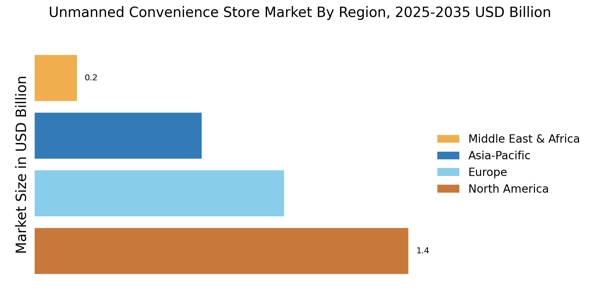Cost Efficiency
Cost efficiency is a pivotal driver in the Unmanned Convenience Store Market, as businesses seek to reduce operational expenses while maximizing profitability. The absence of staff in unmanned stores significantly lowers labor costs, allowing retailers to allocate resources more effectively. Additionally, automated systems reduce the likelihood of human error, further enhancing operational efficiency. Data suggests that unmanned stores can achieve up to 20% lower operational costs compared to traditional convenience stores. This financial advantage is particularly appealing to new entrants in the market, who can leverage technology to establish a competitive edge. As a result, the Unmanned Convenience Store Market is likely to attract more investors and entrepreneurs looking to capitalize on the cost-saving potential of unmanned retail solutions.
Technological Advancements
The Unmanned Convenience Store Market is experiencing a surge in technological advancements that enhance operational efficiency and customer experience. Innovations such as artificial intelligence, machine learning, and advanced payment systems are becoming increasingly prevalent. For instance, the integration of AI-driven inventory management systems allows for real-time tracking of stock levels, reducing waste and ensuring product availability. According to recent data, the adoption of these technologies is projected to increase operational efficiency by up to 30%. This technological evolution not only streamlines processes but also attracts tech-savvy consumers who seek seamless shopping experiences. As a result, the Unmanned Convenience Store Market is likely to witness accelerated growth as businesses invest in cutting-edge technologies to remain competitive.
Changing Consumer Lifestyles
The Unmanned Convenience Store Market is significantly influenced by changing consumer lifestyles that prioritize convenience and speed. As urbanization continues to rise, consumers are increasingly seeking quick and efficient shopping solutions that fit their busy schedules. The demand for 24/7 access to essential goods without the need for human interaction aligns perfectly with the offerings of unmanned stores. Recent surveys indicate that over 60% of consumers express a preference for shopping in environments that minimize wait times and enhance convenience. This shift in consumer behavior is driving the expansion of unmanned convenience stores, as retailers adapt to meet the evolving needs of their clientele. Consequently, the Unmanned Convenience Store Market is poised for substantial growth as it caters to the fast-paced lifestyles of modern consumers.
Increased Focus on Health and Safety
The Unmanned Convenience Store Market is witnessing an increased focus on health and safety, which is reshaping consumer preferences and shopping behaviors. The contactless nature of unmanned stores aligns with the growing demand for hygienic shopping environments. Consumers are increasingly concerned about health risks associated with traditional retail settings, prompting a shift towards automated solutions that minimize human interaction. Recent studies indicate that nearly 70% of consumers feel more comfortable shopping in unmanned environments due to enhanced safety measures. This trend is likely to drive the expansion of unmanned convenience stores, as retailers emphasize cleanliness and safety protocols. Consequently, the Unmanned Convenience Store Market is expected to thrive as it addresses consumer concerns regarding health and safety in the retail space.
Sustainability and Eco-Friendly Practices
Sustainability is becoming a crucial driver in the Unmanned Convenience Store Market, as consumers increasingly prioritize eco-friendly practices. Unmanned stores often utilize energy-efficient technologies and sustainable materials, appealing to environmentally conscious shoppers. The integration of renewable energy sources, such as solar panels, is becoming more common in unmanned store designs, reducing their carbon footprint. Data indicates that approximately 55% of consumers are willing to pay a premium for products from sustainable retailers. This growing demand for sustainability is prompting businesses in the Unmanned Convenience Store Market to adopt greener practices, thereby attracting a broader customer base. As sustainability continues to gain traction, the Unmanned Convenience Store Market is likely to evolve, aligning with the values of modern consumers who seek environmentally responsible shopping options.


















Leave a Comment